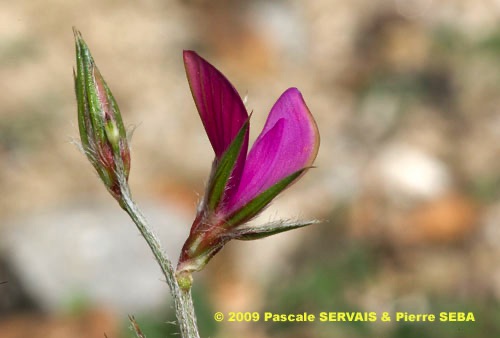
Onobrychis aequidentata (Sm.) d’Urv.
Fam. : Fabaceae
© Pascale SERVAIS & Pierre SEBA, 2018. Tilo Botanica: Flore de Tilos et du Dodécanèse / Flora of Tilos and of the Dodecanese
English translation by Brenda Bradbury, Howard Bradbury and Stéphane Léonard
Plante herbacée, hermaphrodite, dressée à étalée, à tiges poilues, ramifiées.
Feuilles alternes, composées imparipennées, à 11 à 17 folioles, entières, elliptiques à linéaires. Stipules soudées en une seule lame opposée au reste de la feuille.
Fleurs à symétrie bilatérale, pourpre rosâtre, de 9 à 14 mm de long, solitaires ou réunies par 2 à 4 en grappes de 20 à 25 mm de long, à fleurs espacées, à pédoncule bien plus long que la feuille sous-jacente. Corolle papilionacée. Calice étroit, à sépales ciliés, à dents longues et pointues, 4 à 5 fois plus longues que le tube qui est presque glabre. 9 étamines soudées entre elles et 1 libre. Ovaire supère.
Fruits, gousses en forme de disque plus ou moins aplati, de 6 à 12 mm de diamètre, poilues, aux faces creusées de petites fossettes, garnies d’une crête de 4 à 7 dents non épineuses ou garnies de quelques petites épines.
___________________________
Plant herbaceous, hermaphrodite, erect to spread out. Stems hairy, branched.
Leaves alternate, compound imparipinnate, with 11 to 17 entire, elliptic to linear leaflets. Stipules fused in only one blade opposite the rest of the leaf.
Flowers bilaterally symmetrical, pinkish purple, from 9 to 14 mm long, solitary or joined together by 2 to 4 in racemes from 20 to 25 mm long, with spaced flowers, with a peduncle much longer than the underlying leaf. Corolla papilionaceous. Calyx narrow, with ciliate sepals, with long and pointed teeth, 4 to 5 times longer than the tube which is almost glabrous. 9 stamens fused with each other and 1 free. Ovary superior.
Fruits, pods in the shape of a more or less flattened disc, 6 to 12 mm in diameter, hairy, with the faces dug by small cavities, provided with a crest of 4 to 7 nonspiny teeth or with some small thorns.
Descripteurs / Identifying features
1
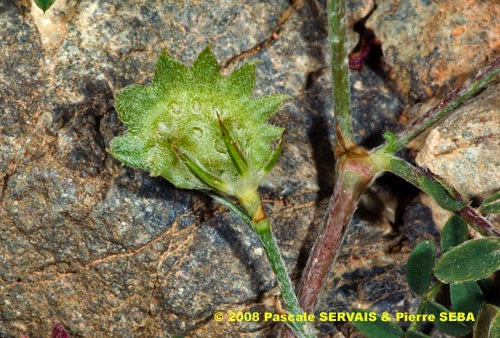
2
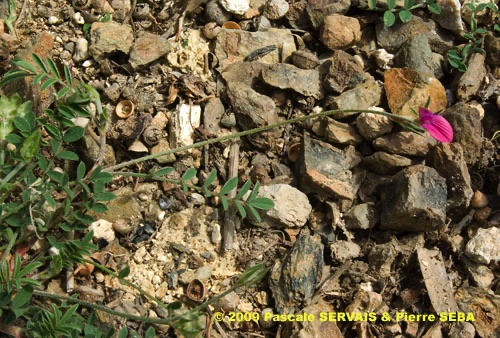
3
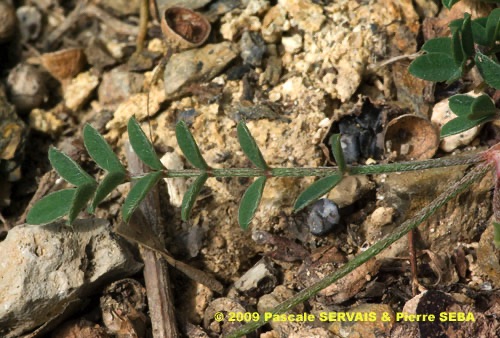
4
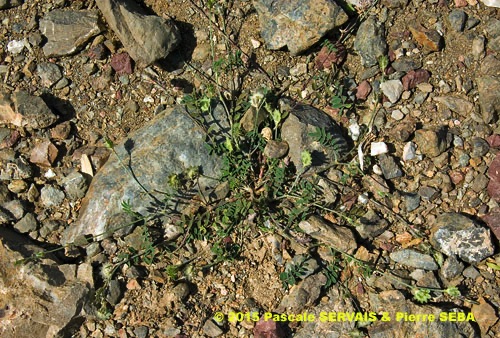
5
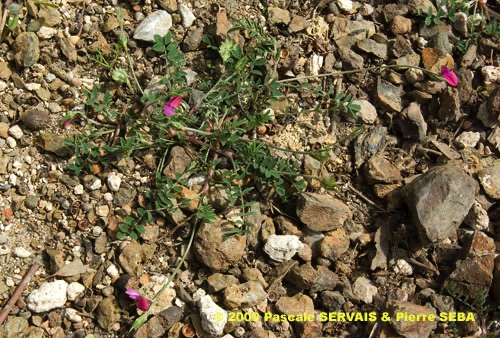
6
Étymologie / Etymology :
Onobrychis : emprunt du latin onobrychis, -idis (nom) = le sainfoin,
nom donné à la plante par Pline, naturaliste latin mort en 79 apr. J.-C.,
forme latinisée du grec ancien ὀνόβρυχις, -ιδις (nom)
[ < ὄνος, -ου (nom) = l’âne + βρύχω (verbe) = grincer des dents,
manger goulûment ] = le sainfoin, nom donné à la plante par
Dioscoride, médecin et botaniste grec mort en 90 apr. J.-C.,
en référence à ses propriétés de plante fourragère.
Aequidentata : adjectif créé par les botanistes [ < aequus, -a, -um (adj.)
= égal, plat + dens, -ntis (nom) = la dent ] = à dents égales, à dents
aplaties, en référence à la forme des dents du fruit.
Onobrychis : borrowed from Latin onobrychis, -idis (noun) = sainfoin,
name given to the plant by Plinius, Latin naturalist died in 79 AD,
Latinized form of the Classical Greek ὀνόβρυχις, -ιδις (noun)
[ < ὄνος, -ου (noun) = donkey + βρύχω (verb) = to squeak of the
teeth, to eat greedily ] = sainfoin, name given to the plant by
Dioscorides, Greek doctor and botanist died in 90 AD, referring to its
properties as a forage plant.
Aequidentata : adjective created by botanists
[ < aequus, -a, -um (adj) = equal, flat + dens, -ntis (noun) = tooth ]
= with equal teeth, with flattened teeth, referring to the shape of the
teeth of the fruit.
Synonymes / Synonyms :
Onobrychis cretica Desv.
Hedysarum aequidentatum Sm.
Hedysarum cristatum Turra
Onobrychis aequidentata subsp. foveolata (DC.) Sirj.
Onobrychis cretica Desv.
Onobrychis foveolata DC.
Onobrychis scapiformis K.Koch
Noms vernaculaires / Common names :
Noms français / French names :
Esparcette à dents égales — Sainfoin à dents égales —
Sainfoin de Crète.
Nom anglais / English name :
Equal-toothed sainfoin.
Nom allemand / German name :
Gleichzähnige Esparsette.
Nom italien / Italian name :
Lupinella con dienti appiattiti.
Habitat :
Forêts - Cultures - Lieux incultes - Sols sableux - Chemins -
Murs, rochers.
Forests - Cultivated places - Waste ground - Sandy soils - Waysides -
Walls, rocks.
Île / Island :
Tilos.
Hauteur / Height range :
De 10 cm à 50 cm.
From 10 cm to 50 cm.
Floraison / Flowering time :
De février à juillet.
From February to July.
Groupe / Classification :
Dicotylédones.
Dicotyledons.
Pérennité / Lifespan :
Annuelle.
Annual.
Description :
Clés dichotomiques et descripteurs distinctifs des 3 espèces / Dichotomous keys and distinctive identifying features of the 3 species
Photo 1 :
Localisation / Location : Tilos, Megalochorio, Plaka
Date : 30/03/2009
GPS : Lat. 36,46375° N / Long. 27,30558° E / Alt. 39 m
Type : Photographie numérique / Digital Photograph (10 mégapixels)
Photo 2 :
Localisation / Location : Tilos, Megalochorio, Plaka
Date : 15/04/2008
GPS : Lat. 36,46375° N / Long. 27,30558° E / Alt. 39 m
Type : Photographie numérique / Digital Photograph (10 mégapixels)
Photo 3 :
Localisation / Location : Tilos, Megalochorio, Plaka
Date : 30/03/2009
GPS : Lat. 36,46375° N / Long. 27,30558° E / Alt. 39 m
Type : Photographie numérique / Digital Photograph (10 mégapixels)
Photo 4 :
Localisation / Location : Tilos, Megalochorio, Plaka
Date : 30/03/2009
GPS : Lat. 36,46375° N / Long. 27,30558° E / Alt. 39 m
Type : Photographie numérique / Digital Photograph (10 mégapixels)
Photo 5 :
Localisation / Location : Tilos, Megalochorio, Plaka
Date : 15/04/2008
GPS : Lat. 36,46375° N / Long. 27,30558° E / Alt. 39 m
Type : Photographie numérique / Digital Photograph (10 mégapixels)
Photo 6 :
Localisation / Location : Tilos, Megalochorio, Plaka
Date : 30/03/2009
GPS : Lat. 36,46375° N / Long. 27,30558° E / Alt. 39 m
Type : Photographie numérique / Digital Photograph (10 mégapixels)

Google Maps
Google Maps
Google Maps
Google Maps
Google Maps
Google Maps